| Pages:
1
2 |
woelen
Super Administrator
        
Posts: 7976
Registered: 20-8-2005
Location: Netherlands
Member Is Offline
Mood: interested
|
|
Thumbs up, very nice to see such quantitative results!
What I find remarkable is the strong yellow/brown "background" color of all samples to which hexacyanoferrate(II) was added. This looks like oxidation
to hexacyanoferrate(III). You said you added two drops of H2O2 (3%) to each sample and one drop of solution of hexacyanoferrate(II). Maybe you had too
much peroxide? This test requires both iron(II) and iron(III). The iron(II) must be in the hexacyanoferrate. If all hexacyanoferrate is oxidized to
the +3 state, then no blue complex is formed anymore, but a brown FeFe(CN)6 complex. This complex is fairly dark brown, but it certainly is not as
strongly colored as the blue FeFe(CN)6(-) complex.
You could try adding just a single drop of H2O2 to each sample, and adding 2 or 3 drops of cyanoferrate(II) to each sample, just to be sure that some
iron(II) remains. Maybe you can increase the sensitivity somewhat.
[Edited on 25-6-15 by woelen]
|
|
|
aga
Forum Drunkard
    
Posts: 7030
Registered: 25-3-2014
Member Is Offline
|
|
Fabulous work agent_entropy !
It is very encouraging for us less experienced people to see how things Should be done.
Great images too.
|
|
|
blogfast25
International Hazard
    
Posts: 10562
Registered: 3-2-2008
Location: Neverland
Member Is Offline
Mood: No Mood
|
|
Yes, nice work indeed. Nice to see something quantitative here for once.
|
|
|
agent_entropy
Hazard to Self
 
Posts: 91
Registered: 17-7-2006
Location: U.S.
Member Is Offline
Mood: No Mood
|
|
I had to be out of the lab for awhile while my first son was born.  <--
shameless bragging <--
shameless bragging
Anyhow, after sitting undisturbed for 111 hours the samples looked quite different. There was a blue precipitate in all of the vials subjected to the
hexacyanoferrate test and there was no color in any of the vials subjected to the thiocyanate test.
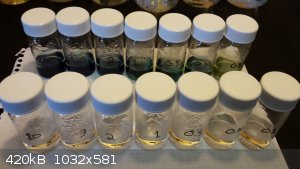
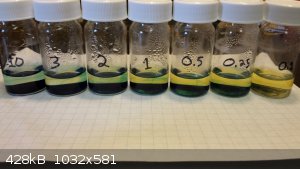
2 drops of 0.2M KSCN were added to each of the thiocyanate vials, and the red color returned immediately.
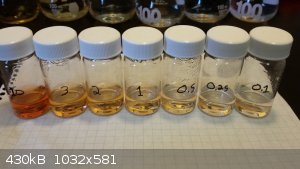
[Edited on 29-6-2015 by agent_entropy]
|
|
|
agent_entropy
Hazard to Self
 
Posts: 91
Registered: 17-7-2006
Location: U.S.
Member Is Offline
Mood: No Mood
|
|
Per woelen's suggestion:
A new set of samples was prepared, again with 5 mL of standard solution each, at 3, 2, 1, 0.5, 0.25, and 0.1 ppm Fe3+.
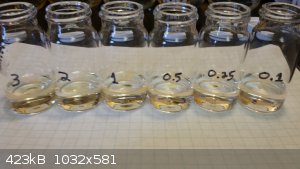
One drop of 3M Nitric acid was added to each vial and swirled to mix.
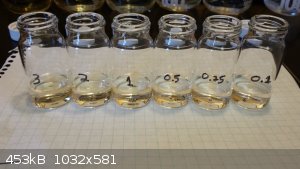
One drop of 3% Hydrogen peroxide was added to each vial and swirled to mix.
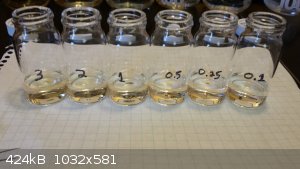
2 drops of 0.2M Potassium hexacyanoferrate (II) were added to each vial and swirled to mix.
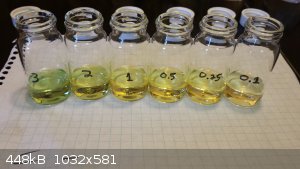
One additional drop of 0.2M Potassium hexacyanoferrate (II) was added to each vial and swirled to mix.
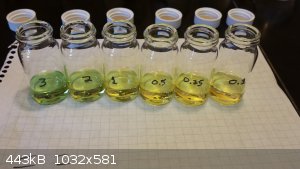
Another additional drop of 0.2M Potassium hexacyanoferrate (II) (for a total of 4 drops) was added to each vial and swirled to mix.
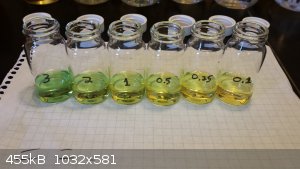
The same yellow coloration as before developed in each vial.
[Edited on 29-6-2015 by agent_entropy]
|
|
|
agent_entropy
Hazard to Self
 
Posts: 91
Registered: 17-7-2006
Location: U.S.
Member Is Offline
Mood: No Mood
|
|
A blank sample was prepared containing only 5 mL deionized water.
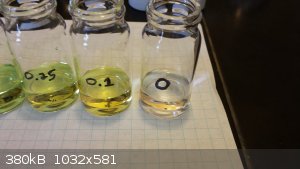
One drop of 3M Nitric acid was added to the blank sample.
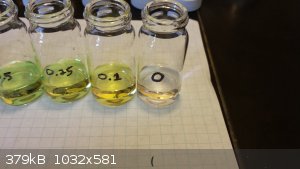
One drop of 3% Hydrogen peroxide was added to the blank sample.
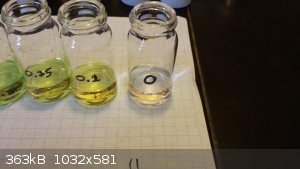
4 drops of Potassium hexacyanoferrate (II) were added to the blank sample.
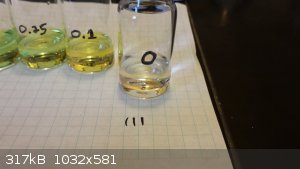
After 12 minutes it was noted that the same yellow color had developed as in the Fe3+ containing samples.
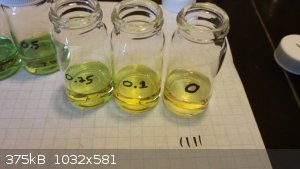
A further control sample was prepared by dissolving a few crystals of FeSO4 in deionized water and a 5 mL aliquot was withdrawn and placed in a vial.
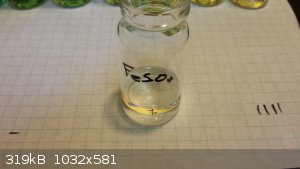
2 drops of 0.2M Potassium hexacyanoferrate (II) were added to the FeSO4 solution and a blue precipitate formed immediately.
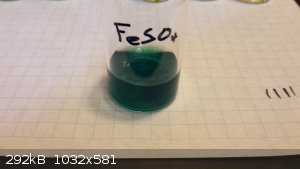
One drop each of 3M Nitric acid and 3% Hydrogen peroxide were added to the FeSO4 solution and the blue color of the precipitate intensified. At the
same time the quantity of precipitate increased.
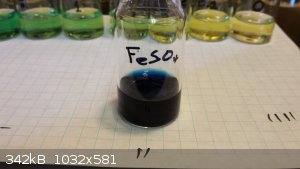
Given the above results, is it possible that the hexacyanoferrate itself is being oxidized to yield the yellow coloration?
Furthermore, how did the blue precipitate form in the FeSO4 sample when only Fe2+ should have been present? (This question is to be taken lightly
since I am not confident in the purity of the FeSO4 used, it was a sample of practical grade industrial material.)
[Edited on 29-6-2015 by agent_entropy]
|
|
|
woelen
Super Administrator
        
Posts: 7976
Registered: 20-8-2005
Location: Netherlands
Member Is Offline
Mood: interested
|
|
VERY good reason of being out of the lab! Congratulations!
The blue precipitate in all your samples does not surprise me. In your experiment you make hexacyanoferrate(III), which in solution is unstable and
forms blue insoluble complexes. For this reason you need to perform the test within a few hours, otherwise all samples turn blue and you cannot
distinguish anymore between the samples.
Interesting to see that your results are very similar with the smaller amount of H2O2 and the extra ferrocyanide. So, my theory of having all
ferrocyanide being oxidized to ferricyanide was wrong. It just was a try to make the test more sensitive, but you already have maximum sensitivity.
|
|
|
agent_entropy
Hazard to Self
 
Posts: 91
Registered: 17-7-2006
Location: U.S.
Member Is Offline
Mood: No Mood
|
|
Thanks! I'm very excited.
I'm also curious about the disappearing color in the thiocyanate samples. I realize the thiocyanate complex is less stable than the ferricyanide, but
I would have expected there to be an equilibrium where it re-forms.
Per wikipedia: FeSCN2+ + OH− → FeOH2+ + SCN−
I guess that makes sense. But they were acidic solutions, there shouldn't be much OH- in there.
EDIT:
Nevermind. Same Wiki page, "Thiocyanatoiron decomposes with exposure to light."
[Edited on 29-6-2015 by agent_entropy]
|
|
|
blogfast25
International Hazard
    
Posts: 10562
Registered: 3-2-2008
Location: Neverland
Member Is Offline
Mood: No Mood
|
|
Congrats with the baby. I'll 'wet his head' tonight! 
Aha! Light decomposing 'thiocyanatoiron'? That would explain it.
That would also be easy to prevent: a strong excess of SCN<sup>-</sup>(aq) should mean most Fe<sup>3+</sup> is always
complexed or at least during measurement/detection, unless the complex Fe(OH)<sup>2+</sup> is much stronger than
FeSCN<sup>2+</sup> but then low pH (low [OH<sup>-</sup>]) needs to be taken into account too.
Incidentally, FeSO4 will nearly always test positive for Fe(+3) due to partial oxidation and the sensitivity of the 'Prussian Blue' test. 'Good
quality' Mohr's Salt - (NH4)2Fe(SO4)2 - is to be preferred to FeSO4 as an Fe(+2) standard because its acidity slows down oxidation of Fe(+2) to
Fe(+3). Mohr's salt is easy to prepare and easy to recrystallise for better purity.
[Edited on 29-6-2015 by blogfast25]
|
|
|
aga
Forum Drunkard
    
Posts: 7030
Registered: 25-3-2014
Member Is Offline
|
|
Congratulations on all fronts !
Take time out from the lab to Be There for your Wife and Son : you will not regret it.
Chemistry can wait.
|
|
|
AJKOER
Radically Dubious
    
Posts: 3026
Registered: 7-5-2011
Member Is Offline
Mood: No Mood
|
|
After reading the following found on Atomistry.com on FeCl3 (link: http://iron.atomistry.com/ferric_chloride.html ):
"Alcoholic solutions of ferric chloride are reduced by light, which acts, not as a catalyst, but as a generator of the necessary chemical energy.
Ferrous chloride, hydrogen chloride, and formaldehyde are the primary products of the reaction."
It occurred to me that based on photo-fenton chemistry (as some background, see for example, "Fundamental Mechanistic Studies of the Photo-Fenton
Reaction for the Degradation of Organic Pollutants" at https://www.google.com/url?sa=t&source=web&rct=j&... ), perhaps an auxilary test based on a non-visual sense as it would be hard to
compete with the excellent prior suggested procedures anyway. That is, I am suggesting a test based on the sense of smell relating to formaldehyde
formation.
My take on the reaction path: the formation of the methyl radical and subsequent reattack by another hydroxyl radical:
CH3OH + HO. → CH3. + H2O
CH3. + HO. → CH2O + H2O
I know, this test obviously 'stinks', but some may find it useful nevertheless. Note, formaldehyde has been described as being toxic, allergenic, and
carcinogenic, so take appropriate safety precautions to limit exposure.
------------------------------------------------
Note, the comments on Atomistry.com are actually extracts from the reputedly authoritative sources over the years. However, some of the material may
be quite dated as is the case, I suspect, with the extract above. I would not be surprised if the reaction, however, was discovered owing to the
evident formaldehyde formation.
[Edited on 30-6-2015 by AJKOER]
|
|
|
AJKOER
Radically Dubious
    
Posts: 3026
Registered: 7-5-2011
Member Is Offline
Mood: No Mood
|
|
Quote: Originally posted by AJKOER  | .....
My take on the reaction path: the formation of the methyl radical and subsequent reattack by another hydroxyl radical:
CH3OH + HO. → CH3. + H2O
CH3. + HO. → CH2O + H2O
..... |
Actually, I should have posted:
My take on the reaction path: the formation of the methoxy radical and subsequent reattack by another hydroxyl radical:
CH3OH + HO. → CH3O. + H2O
CH3O. + HO. → CH2O + H2O
Here is a confirming source, "Low Temperature Kinetics of the CH3OH + OH Reaction", published in J Phys Chem A. 2014 Apr 17; 118(15): 2693–2701., in
particular pages 2 and 17, link: http://www.ncbi.nlm.nih.gov/pmc/articles/PMC4190665/
[Edited on 2-7-2015 by AJKOER]
|
|
|
| Pages:
1
2 |